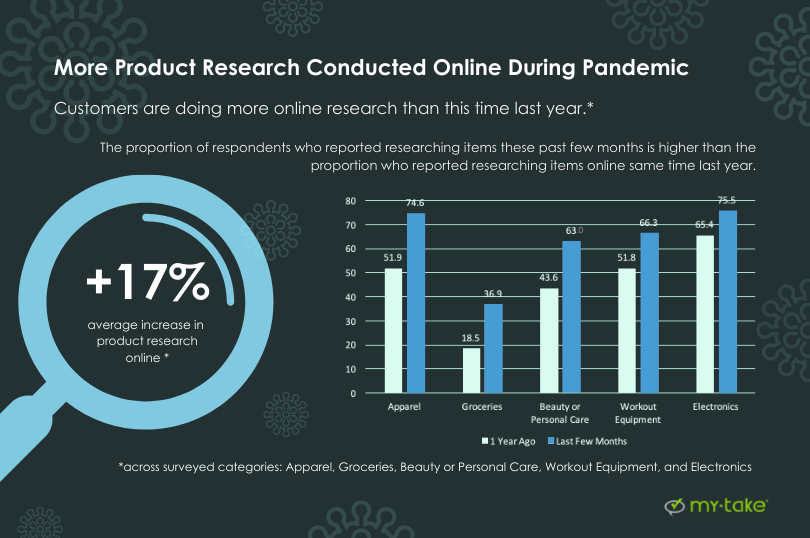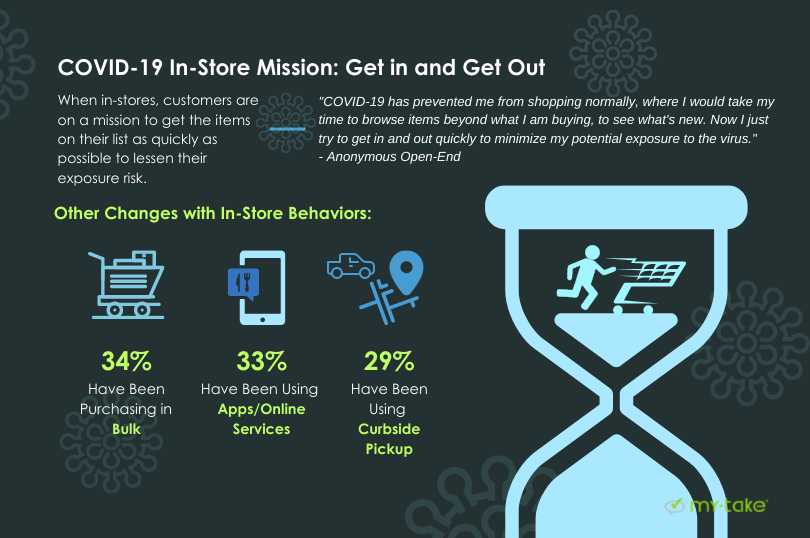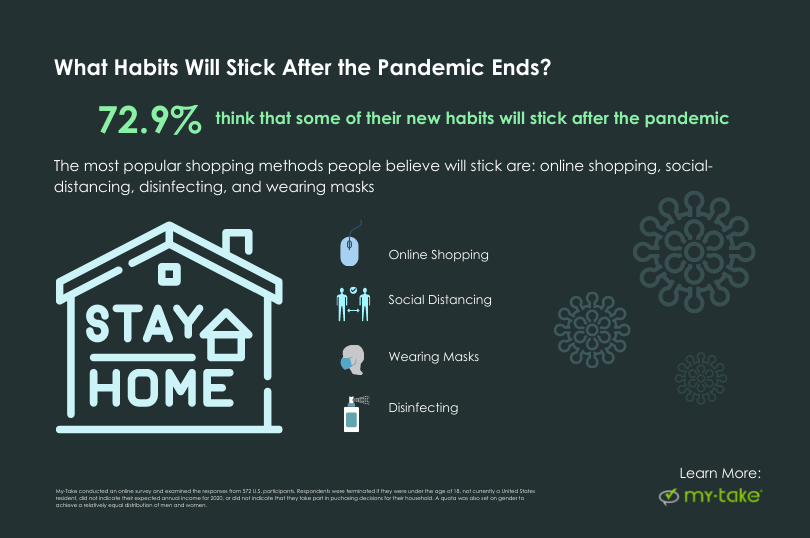COVID-19 Online Shopping: Changed Forever, or For Now? (Infographic)
Seven months later, and the COVID-19 pandemic has altered the buyer’s journey for consumers in some ways that may continue well into the future. With expert recommendations to distance and stay home, many consumers are reducing the amount of time they spend shopping in-store and replacing this time with online methods.
Online Shopping Trends During COVID-19
Buying More Online
The challenging aspects of the pandemic have forced many to be mostly confined to their homes. It is no surprise that for many an immediate concern was to secure staples, however people also had more free time to devote to themselves and initiatives they don’t typically have time to address. When surveyed, 65% of respondents indicated an increase in their online shopping.
Purchasing Safety + Staples+ Home/Life Improvements
What have people transitioned to purchasing online the most? During the pandemic, there have been a few different priorities on people’s minds:
1. Buying products to protect themselves (masks, sanitizers, etc.)
2. Buying products needed (staples of life like food to survive in their homes
3. Buying products to improve quality of life at home (entertainment, home improvement & work from home items)
4. Buying product to for personal improvement/development (personal care/beauty, apparel, work out equipment)

When asked over the last few months which product categories were purchased more/less/or the same as last year, Apparel has seen a 29% increase, Personal care and beauty items have seen a 24% increase from the same time last year to now, Electronic shopping 19%, Workout equipment has increased by 12%, and Grocery shopping online has increased 11.
These increases are the result of many factors: more have had time and want to stay busy and healthy while at home through working out and taking care of themselves. Some have also had to purchase work-from-home setups to replace their offices, and have even opted to grocery shop online for delivery or pickup to be on the cautious side.
When asked about essential and non-essential purchase changes in the last few months, 38% of respondents reported spending more on essential items than usual and 14% reported spending more on non-essential items than normal.
When asked about unusual and out of the ordinary purchases made throughout the last few months the items most frequently cited included:

Items to Protect
- Personal Protective Equipment (PPE)/sanitation items
Items Needed (The Staples)
- Groceries/food
- Toiletries
Items Bought Due to More Time at Home
- Home improvement supplies
- Personal care and beauty products
- Activewear/exercise accessories
- Non-perishable food
- Gardening/outdoors/livestock
- Video games
- Books/puzzles/board games
- Kitchen supplies
- Arts and crafts

More Time to Research
One of the many benefits of purchasing items online, is the ability to research first. These days, there are many channels in which consumers can seek product reviews from, compare brands, as well as search for the best deal. For products in industries such as Apparel, Personal Care/Beauty, Workout Equipment and Technology, many customers research online versus in-store.
In fact, the proportion of individuals who indicated researching these items in the last few months has increased by 17% on average in total when compared to last year. This could point to the idea that with less hours to spend browsing in-stores, consumers are switching to online channels to make up lost time.

Mission: Get in and Out of the Store
These days, when consumers enter a store in-person they have one mission on their mind: “Get what I need, and get out”. Many customers are avoiding frequent in-person shopping by purchasing products in bulk, which reduces the number of store trips or online orders needed to get essential items. Some are also choosing to utilize curbside pickup, app/online service, and/or delivery options to decrease the risk of in-person shopping.
When asked about personal shopping habits in the last few months, 34% of those surveyed indicated that they have been buying more items in bulk, 33% are using apps/online services more to shop, and 29% are doing more curbside pickup.
Customers are choosing these methods of purchasing to overall lessen the amount of time spent in-stores. Following stay at home orders, consumers feel more secure and safe by having a stockpile of items they need and the ability to go pick something up at a moment’s notice or have it delivered without leaving the comfort and safety of their vehicle or homes. These options lessen the uncertainty in a customer’s mind of when they may be able to get their hands on a product they need or want, safely.

What Will Stick?
All in all, many consumers believe some of these new shopping habits will stick after the end of the pandemic. The majority of respondents (72.9%<) say that some of the new habits will stick after the pandemic. The most popular shopping method people believe will stick are online shopping, social distancing, disinfecting, and wearing masks.
Implications + Recommendations
With all of these data points in mind, here are some recommendations for organizations trying to help customers improve their experience and ease their transition.
Adapt:
Have an overall awareness that things may not go back to normal soon and realize that adjustments to strategy, if not the business model, may need to be made.
Enhance Online Channels:
Customers have new expectations and need for options when it comes to an organization’s digital abilities. Some ways of enhancing the online shopping experience include: adding high quality product images, showing user-reviews, displaying product or service specifications and cross-brand comparisons, as well as having fast shipping, curbside pickup and/or takeout options available. Through these optimizations, consumers are able to feel safe and confident in their purchase, even if they’ve never seen the product in person.
More Research & Better Analytics/AI:
For customer-first organizations, cutting-edge analytics and AI are needed more than ever to be able to understand changing consumer habits and preferences. The feedback loop and decision making process need to faster and more efficient to be able to adapt to what consumers need during these times and going forward. Integrating VoC feedback through communities can unlock actionable insights.
Purchase Path Focus & Understanding:
Conduct more research on customers to understand their path to purchase in greater detail. With the amount of change taking place it is critical that organizations understand their consumers’ path to purchase. This type of research can lead to an understanding of how a customer begins their journey to their overall user experience (UX), and can also uncover any pain points they might encounter along the way. One way organizations can conduct purchase path research is to run studies analyzing the UX of their websites.
Optimize Experience Based on Shifting Preferences and Needs:
Offering items in bulk, for curbside pickup, takeout, or creating products with sanitization and safety in mind just a few ways brands can appeal to changing consumer preferences and safety needs.
Trying to understand changing consumer shopping habits? My-Take has helped organizations make smarter decisions through powerful market research online communities and panels for 10 years now! Contact our team today to learn more about how our market research online community platform can connect your brand with your consumers and unlock actionable insights.
